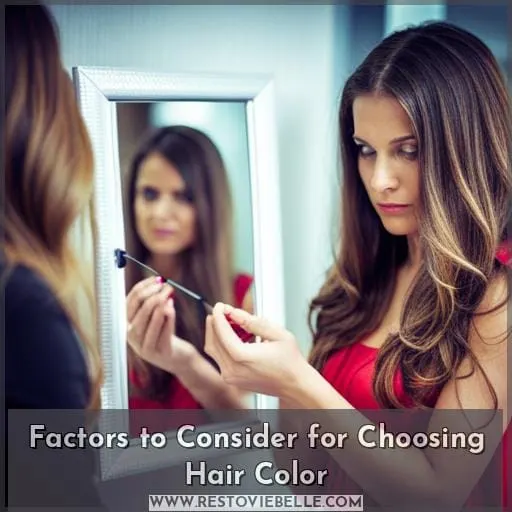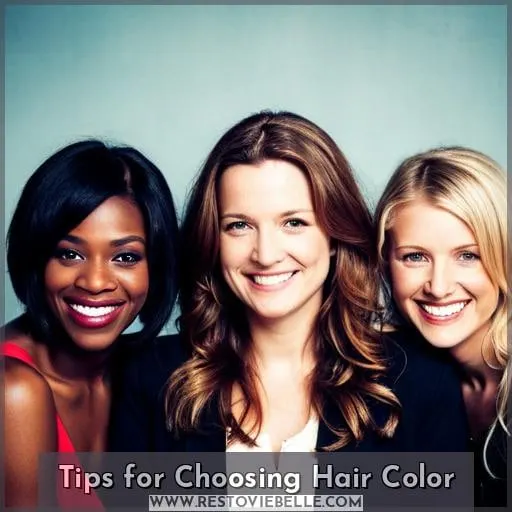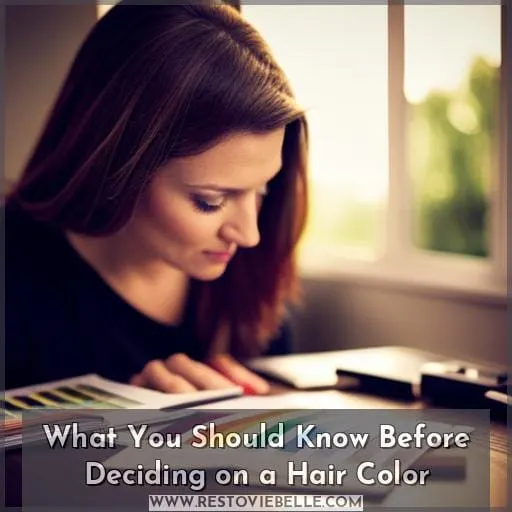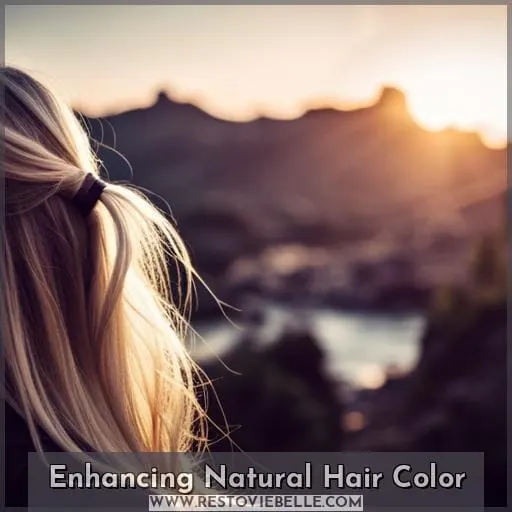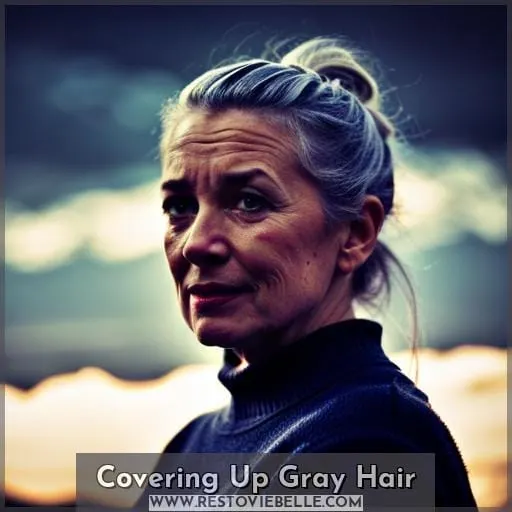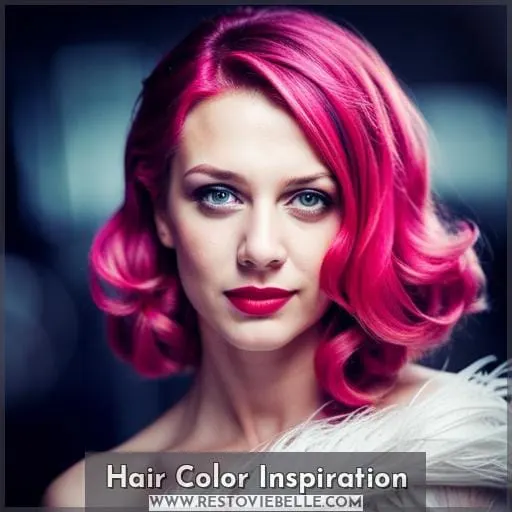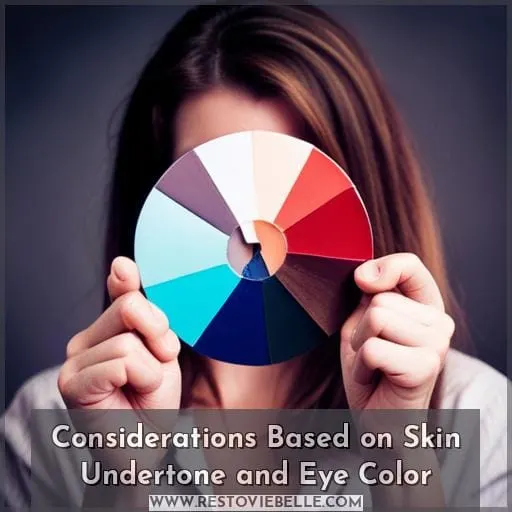This site is supported by our readers. We may earn a commission, at no cost to you, if you purchase through links.
 You’re ready for a hair makeover so extreme, it will have people turning their heads. With the right color choice, you can make a statement that reflects your personality and style.
You’re ready for a hair makeover so extreme, it will have people turning their heads. With the right color choice, you can make a statement that reflects your personality and style.
We’ve got the answer: take our quiz to find your ideal match! Whether it’s warm or cool tones, blondes or brunettes, we’ll help identify which hue will bring out the best in you. And don’t worry if dyeing isn’t an option – we also provide tips on how to enhance your natural color.
So break away from boring hair days and get creative with colors that suit YOU!
Table Of Contents
- Key Takeaways
- Factors to Consider for Choosing Hair Color
- Tips for Choosing Hair Color
- What You Should Know Before Deciding on a Hair Color
- Enhancing Natural Hair Color
- Covering Up Gray Hair
- Hair Color Inspiration
- Considerations Based on Skin Undertone and Eye Color
- Frequently Asked Questions (FAQs)
- Conclusion
Key Takeaways
- Personality and style should guide hair color choice.
- Consider skin tone, undertones, and eye color when selecting a color.
- Gradual transition and experimentation can be done for dramatic changes.
- Gray hair coverage and hair color trends are important considerations.
Factors to Consider for Choosing Hair Color
Choosing the right hair color can be a daunting task, but with some key considerations in mind, it doesn’t have to be. Consider your motivation and commitment level for dyeing your hair. Think about how close you want to stay to your natural shade.
Also, consider whether you will need additional products based on the texture of your hair. Reflect on any colors that complemented or clashed with yours when you had it as a child. Think about whether blond tones are something that would suit you best, and finally, if brunette tones might also work better for the look you are trying to achieve.
Motivation and Commitment Level
You owe it to yourself to take the time, energy, and money needed for your ideal shade – something that will boost your confidence, mood, and self-acceptance. Consider the commitment level required of you in terms of hair maintenance, as well as the potential emotional changes a hair color change may bring.
Assess if any damage has been done to your strands due to previous coloring or not taking proper care of them before deciding on a dye job. Research various colors and their effects through virtual try-ons so you can reach closer to achieving those desired goals! Be sure that when selecting shades, they match up with both skin tone undertones and natural base color for optimal results.
Your Natural Shade
Matching with your natural shade is key to finding a look that will flatter you. It’s important to consider the tone of your skin and undertones when selecting color, as well as hair texture, porosity, and thickness for optimal absorption.
To enhance your existing shade without making drastic changes, try using glosses or glazes, which are much less damaging than other types of dyeing products. Transition gradually if aiming for a dramatic change in order to avoid an excessive harsh contrast between shades.
Hair care routine should also be taken into account since moisture absorbency affects how long the color lasts on strands – so make sure it’s nourished! With these tips, you can find a hue that works best with both personal style and complexion needs – plus adds a confidence boost too!
Your Hair Texture
Assess your hair texture, noting porosity and thickness, to understand how the hue will take. Dye types – semi-permanent, demi-permanent, or permanent – will also influence color absorption. To maintain healthy hair during the dyeing process, opt for nourishing products such as glosses and glazes.
Additionally, consider factors like desired maintenance level, time commitment, and money required when selecting a shade.
Your Hair Color as a Child
Remembering the hue of your hair color as a child can give you an idea of what colors will look best on you now. It’s important to consider undertones, texture, and tone balancing when selecting a new shade.
For example:
| Skin Tone | Undertone | Hair Color Choices |
|---|---|---|
| Warm | Light Brown | Chocolate, Auburn |
| Cool | Platinum Blonde | Smoky Brown, Wheat Blonde |
| Neutral | Medium Ash Brown | Chestnut, Silver, Rose Gold, Scarlet, Beige, Deep Mocha, Caramel, Red-Brown, Ash Blonde, Eggplant, Raven, Jet Black, Bronde, Cream |
Matching with natural shades helps create balanced looks that flatter different skin tones.
If Your Result Includes Blond Tones
If your result includes blond tones, imagine yourself as a golden sunbeam radiating confidence and beauty.
It’s important to consider warm or cool undertones when selecting blonde shades that will best compliment your skin tone. If you’d like to add highlights for more vivid colors, consult with a colorist who can help curate the perfect hair transformation for you.
Glosses and glazes are also great options if you want to switch up warm or cool colors without fully committing yet! A consultation can offer insight into the different possibilities of highlighting techniques available and how they might look on various lengths of hair–so don’t hesitate to seek out professional advice!
If Your Result Includes Brunette Tones
For brunette tones, you’ll want to choose shades like mahogany, honey blonde, and golden blonde that will complement your warm undertones. Natural tones like chestnut silver also work well with cool undertones for a unique look.
To ensure the best results, color match to your skin tone or opt for hair gloss treatments, which can transform the hue of any shade without damaging hair health.
Experimenting with glazes is an ideal option if you’re looking to enhance natural colors while avoiding drastic changes in hue altogether.
Tips for Choosing Hair Color
Choosing the right hair color can be a daunting task. From skin tone and color selection to matching with natural shade, transition and gradual effects, hair care and maintenance, experimentation and advice – even virtual try-ons – there are many considerations when it comes to selecting the perfect hue for you.
And don’t forget eye color, which can influence your choice too! So let’s explore how to make this decision easier by looking at some tips on choosing the right hair color.
Skin Tone and Color Selection
Choose wisely! Your skin tone and undertones will dictate the hues you should explore for a picture-perfect ‘do.
For light skin, warm tones work best with chocolate, light brown, or auburn. Cool tones suit platinum blonde, smoky brown, or wheat blond.
Medium complexions look great in mahogany, honey blonde, golden blondes. Cooler shades of ash, chestnut, and silver are good too if your undertone is cooler, while rose gold, scarlet beige is ideal if it’s neutral.
Deep-skinned beauties can rock mocha, caramel, red-browns when their undertone is warm. Eggplant, raven works well with cooler undertones, whilst jet black, bronde, cream looks stunning on those who have more balanced undertones.
Matching With Natural Shade
Sticking close to your natural hues is the key to achieving a balanced look. While dyeing techniques, hair gloss, and glazes can help you achieve rich color, try matching with your natural shade for best results.
If you have cool undertones, opt for shades near ash brunette or silver. For warm undertones, suit colors like honey blonde or golden blonde. Neutral undertones should pick from both warm and cool tones, such as beige, bronde, or cream, for a vibrant yet subtle result that requires minimal maintenance.
For an added touch of luxury, use glosses and glazes which will enhance your existing hue without much effort – making sure you get all the compliments without any of the damage!
Transition and Gradual Effects
Try transitioning gradually for a dramatic color change, mixing and matching techniques to suit your individual style. Dip dyeing is popular with multi-tonal hues and glossy shades, while pastel tones can be blended into natural hair shades for more subtle changes.
Hair glosses are an easy way to add some sparkle and protect the hair from damage when making drastic changes in color! For those looking for extra inspiration, online sources offer plenty of ideas when it comes to choosing colors and transforming your look.
Hair Care and Maintenance
Maintaining healthy hair is essential for achieving the desired outcome when choosing a new shade, so be sure to assess your hair’s strength and porosity before committing. To do that, conduct strand tests, use color-matching tools online, and ask for professional advice.
Glazing techniques, gloss treatments, and color depositing shampoos help ensure long-lasting results.
Incorporate glazes or glosses into routine maintenance while also using professional products designed specifically for colored strands.
Experimentation and Advice
Explore the different mix-and-match techniques to find your perfect shade. Discover even more advice from Hair Color 101, like hair care tips and virtual try-ons for color experimentation. Personal factors such as eye color also influence hair color choices, while various techniques – like glosses and glazes – can enhance natural hues.
Virtual Try-on and Product Use
You can test out various hues with the Virtual Try-On and get an idea of how they’ll look on you, without having to commit. Find your celebrity twin or create something entirely new – from classic fashion colors to vibrant hair shades.
Experiment with different dye types for a long-lasting effect, or use glosses and glazes as subtle enhancements that refresh your current color while giving it added shine. Consider eye color too; harmonizing tones will give you maximum impact! Hair health is key: assess texture before taking any action so hair absorbs product properly for desired results.
Influence of Eye Color
Gaze into your eyes and see what hair color enhances their hue! Eye color is an important factor when selecting a hair shade. Consider jet black for dark eyes, ash blonde or golden brown for light-colored irises, or caramel highlights to bring out hazel tones.
Combining colors can create unique effects; try tinting shades with contrasting hues of the same tone to match your eye’s pigmentation. Your texture also matters; low porosity locks need lighter dyes while dense tresses require darker shades.
With proper maintenance, you can achieve long-lasting healthy hair in fashionable shades based on your eye color too!
What You Should Know Before Deciding on a Hair Color
Deciding on a hair color for yourself can be an exciting but daunting task. From considering your hair texture and health to determining the best shade for your skin tone and undertones, there’s so much to consider before making any decisions.
Hair Texture
Take a moment to consider the texture of your locks, whether they are fine and wispy or thick and unruly. The porosity or absorbency of your hair may affect the outcome of any coloring you choose. Hair color types vary from semi-permanent to permanent dyes, and shades range from cool undertones like silver blonde to warm red tones like copper.
Enhance natural colors with glosses or try mix-and-match techniques for a unique look! If you want an overall change in tone, need coverage for grays, or just crave something new, consider dyeing your hair.
Carefully consider factors such as skin tone and texture to select the perfect hair color that reflects your personality.
Hair Health
Evaluate your hair’s health before making a decision on color, for as the saying goes: ‘prevention is better than cure’.
Hair porosity and thickness affect dye absorption, so check moisture levels too.
Damaged hair can drastically affect the outcome, while glosses and glazes provide vibrant colors without damage.
Use virtual try-on to experiment with seasonal shades or mix-and-match techniques to bring out your complexion.
Colors like jet black and scarlet are trending now – but make sure you choose wisely based on the maintenance level required!
To find the perfect shade that reflects your style without damaging strands, use these tips & color techniques for a liberating look this season!
Current and Natural Hair Color
Compare your current hair color to the shade of your natural hue, and assess how much of a change you’re comfortable with. Go blonde or brunette? Rock red or pink? Consider dye types, like semi-permanent, demi-permanent, and permanent.
Hair glosses are an easy way to transform the look without committing long term; enhance natural shades for subtle changes that can still give a big impact! To make sure you love it before making any drastic decisions, use virtual try-ons so there are no surprises post-dyeing session.
And don’t forget about natural undertones when picking out colors – warm ones match with warm hues while cool tones go well with cooler shades.
Skin Tone
Examine your skin tone and undertones to decide which hair colors suit you best. Consider light, medium, or deep complexions with warm, cool, or neutral hues that pair well with shades of chocolate, platinum blonde, mahogany, and more! When selecting a color:
- Evaluate hair health and texture for moisture absorption.
- Stick close to the natural shade for better results.
- Use Virtual Try Ons and colored care products for nourishment.
- Eye color also influences choices; experiment accordingly! Hair dyeing offers liberation in expression while reflecting personal growth—so enjoy the journey towards finding your perfect hue!
Skin Undertones
Choose the hair hue that best complements your skin’s underlying tones for a vibrant look. When it comes to color selection, consider your complexion and any warm or cool undertones present. Light complexions with warm undertones should go for chocolate, light brown, or auburn.
Those with cool tonality may opt for platinum blonde, smoky brown, or wheat blonde.
Medium hues can pair mahogany and honey blondes with warm tones, while ash browns and chestnuts work better with cooler ones. Deep-skinned beauties benefit from mocha caramel red-browns if they have warmer bases, while eggplant raven is ideal in case of cooler base colors.
Enhancing Natural Hair Color
Deciding on the right hair color for you can be a difficult task. With warm, cool, and neutral undertones to consider, it’s important to understand what options are available that will best complement your skin tone before committing to one particular shade.
Warm Undertones
If you’ve got warm undertones, try shades like mahogany, honey blonde, or golden blonde to bring out your natural beauty! Dyeing basics emphasize color selection according to skin tone. Hair health is also a key factor, and strand tests can reveal strength for the perfect shade.
Check out current trends if unsure – then gloss it up with hair colors that flatter your complexion and rock the look! Color glosses are an easy way to enhance hues without fully committing; mix-and-match techniques offer endless possibilities too.
So go on, embrace yourself in all its glory – find a hue that works best for you!
Neutral Undertones
Treat yourself to a balanced look by selecting hues that are complementary to your neutral undertones – think blushing beige, creamy chestnut, and sable brown! Follow the latest hair color trends and explore dye application tips.
Keep hair protected with nourishing products as you experiment with color combinations.
Color selection can make or break an overall look, so take time deciding on the perfect shade for you. Have fun playing around with fashion-forward shades that will have people turning their heads when they catch sight of your new locks! From light caramel highlights to glossy black depths, there’s something for everyone no matter what their tone might be – all without damaging precious strands in the process.
Cool Undertones
Cool undertones call for shades such as ash brown, chestnut, and silver to bring out the best in your complexion. When dyeing with cool tones, hair health is paramount, so assess porosity and strength before coloring.
Use glosses or glazes to enhance natural color without compromising hair integrity.
Covering Up Gray Hair
Covering up gray hair can give you a youthful look and be a confidence booster, so why not give it a try? Gray coverage is essential for those looking to keep their hair looking vibrant and fresh.
Hair dye comes in all sorts of shades, from natural-looking tones to trendy colors that’ll make your style stand out. Tone matching is key when selecting the right hue, as it ensures that the color blends seamlessly with your current locks.
To finish off any new shade perfectly, consider adding an extra boost with regular color gloss treatments. These treatments help protect against fading while leaving strands looking glossy and healthy.
So why not make this change today? With these tips on hand, you’ll have no problem finding the perfect hue for covering up gray hairs!
Hair Color Inspiration
Explore the latest hair color trends and find inspiration for a look that expresses your personality – try something new, it’s always worth a shot!
From mix-and-match techniques to bold colors, there are endless possibilities out there. Experiment with unique color combinations like rose gold and scarlet or opt for subtle hues such as ash blonde.
Hair glosses can transform your locks quickly without damaging them – from platinum blonde to mocha brown! Home kits make it easy to recreate these looks in the comfort of your own home too.
For an extra pop of flair, incorporate some metallic tones or pastel shades into the mix; you’ll be sure to stand out from the crowd with an eye-catching hue that reflects your personal style perfectly.
Whatever you decide on – have fun experimenting and take pride in showing off those newly dyed tresses!
Considerations Based on Skin Undertone and Eye Color
When considering what hair color to choose, take into account your skin undertone and eye color to achieve a look that perfectly suits you. Light skin tones with warm undertones can benefit from chocolate, light brown, or auburn shades, while cool undertones should opt for platinum blonde, smoky brown, or wheat blonde.
Medium skins are complemented by mahogany and honey blondes, as well as golden brunettes. Those with neutral hues may experiment with rose golds and scarlets. Darker complexions suit mochas, caramels, or red-browns, whereas ash blondes, eggplants, and raven locks work best on cool-toned skins.
Consider texture too – porous hair absorbs dye better than thicker strands – while damaged tresses need special attention before any drastic changes occur! Dye types also play an important part in the decision-making process: semi-permanent colors add vibrancy without commitment, whilst permanent solutions bring intense change but demand more maintenance over time.
Color matching works wonders when done correctly, so ensure you select pigments that will enhance rather than overwhelm your complexion and eye shades!
Frequently Asked Questions (FAQs)
What are the best hair dyes for my hair type?
Choose a hair dye that suits your hair type and desired outcome. Let your skin tone guide you, as warm undertones go with warm colors and cool undertones with cooler shades.
How long should I wait between hair colorings?
Wait at least 4-6 weeks between colorings to give your hair time to recover and avoid damage. Change up the shades gradually, so you can enjoy a new look without stressing out your strands! Experiment with glosses or glazes in between for an extra touch of shine.
What is the difference between semi-permanent and permanent dyes?
Semi-permanent hair dye is a temporary color that will fade over time, while permanent dye provides longer-lasting results. Experiment with mix-and-match techniques for fun and unique styles or opt for something subtle to enhance your natural shade.
What are the best products to use to maintain my color?
To maintain your hair color, try using colored hair care products that are designed to nourish and protect. For extra protection, use a gloss or glaze to help lock in the shade and keep it vibrant. Experiment with mix-and-match techniques for added flair! Virtual Try-On can also be used if you’re unsure of what will look best before making a commitment.
How do I achieve a natural-looking hair color?
Choose a color close to your natural shade for an effortless, natural-looking hue. Experiment with mix-and-match techniques and use glosses and glazes to enhance existing tones.
Conclusion
Finding the perfect hair color for you can be a daunting task, but with the right motivation and commitment, you can find the perfect color for you! Consider your natural shade, hair texture, skin tone, and undertones before deciding on a color.
A great way to start is by using coloring techniques such as glosses and glazes to enhance your natural color, or by gradually transitioning to a new color. If you’re looking for inspiration, consider using the virtual try-on tool or the 1-minute quiz to find your perfect shade.
With a little time and effort, you’ll be able to find the perfect color to dye your hair that will make you look and feel great!

